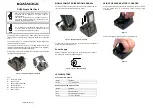
BEFORE YOU BEGIN:
1.
IMPORTANT:
Insert batteries into the home receiver unit first, then the
remote sensor.
2. Place the home unit as close as possible to the remote unit. This will
help with synchronization between the remote sensor and the home unit.
3.
REMEMBER:
Once you are ready to position your remote sensor and
home unit, ensure that the distance is not outside the effective trans-
mission range (100 feet). Some building materials and location of the
home unit or remote sensor can affect transmission quality and range.
Try various locations for best results.
BATTERY INSTALLATION
Home Receiver:
Lift off the battery cover on the back of the unit. Install 2 alkaline AA bat-
teries according to the polarity indicated. Close the battery cover.
Remote Sensor:
Remove the attached bracket stand. Loosen the 2 screws securing the
battery cover with a small screwdriver and remove. Insert 2 alkaline AA bat-
teries according to the polarity direction indicated. Replace the cover and
tighten the 2 screws.
NOTE: There are no consumer serviceable parts. All questions or
service request should directed to our consumer relations department.
(See Warranty section for contact information.)
SETTING UP THE WIRELESS
THERMOMETER:
If you encounter any difficulties in setting up your wireless thermometer
system, please contact Consumer Relations.
• For the first installation, always insert batteries into the home unit
FIRST
and then the remote sensor(s). (See BATTERY INSTALLATION section)
• Your new RF Thermometer is built with random security code technology,
the home unit will learn the random code of the first remote sensor and
log it in as channel 1. Channel 2 and Channel 3 will be registered in the
same way if additional sensors are used. This unit can monitor up to 3
separate sensors.
• Once a channel is registered, it will not accept any new sensors. However,
registered channels can be erased by removing the batteries in the
remote sensor or the home unit.
•
When replacing batteries for the remote sensor
- Remember to clear the
corresponding channel of the home unit by removing the batteries. –OR–
Select the respective channel of the sensor by pressing the CHANNEL
button. Hold the CHANNEL button for 3 seconds to clear the registration.
•
When replacing batteries for the home receiver
- Please remove the bat-
teries of all remote sensors. Once you have replaced the home receiver
batteries, re-install the batteries to the sensors according to the desired
channel sequence. This will ensure that the unit and the remote sensors
are properly synchronized.
• Press the Tx button on the back of remote sensor to verify the RF reception.
• It is recommended to test the units next to each other to ensure that both
the remote sensor and home receiver are properly synchronized.
NOTE: Keep the remote sensor out of direct sunlight and rain. Do not
mount on metal surface.
SETTING TIME
About the Atomic Clock
The National Institute of Standard and Technology (NIST) in Fort Collins,
Colorado broadcasts the time signal (WWVB at 60kHz AM radio signal) with
an accuracy of 1 second per every 3,000 years. The signal will able to cover
over a distance up to 2,000 miles from the source. Like a typical AM radio,
your Atomic Clock will not able to receive the WWVB signal in places sur-
rounded by heavy concrete or metal panels. The reception of the time
signal can be affected by mobile phones, tv, electrical appliances or other
electronic interference. To get the best performance of the Atomic clock,
please install the home receiver near a window and away from large metallic
objects. If the unit is not working properly, change the unit position. There
maybe some interference at this location.
2
3






























